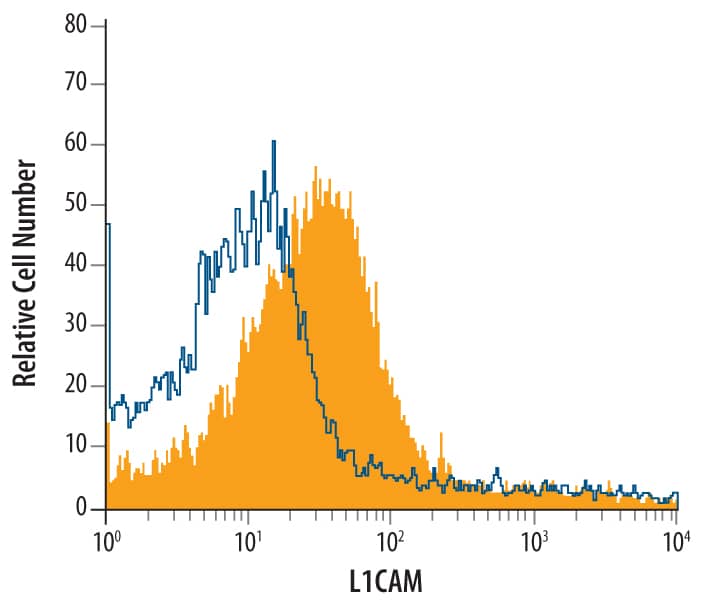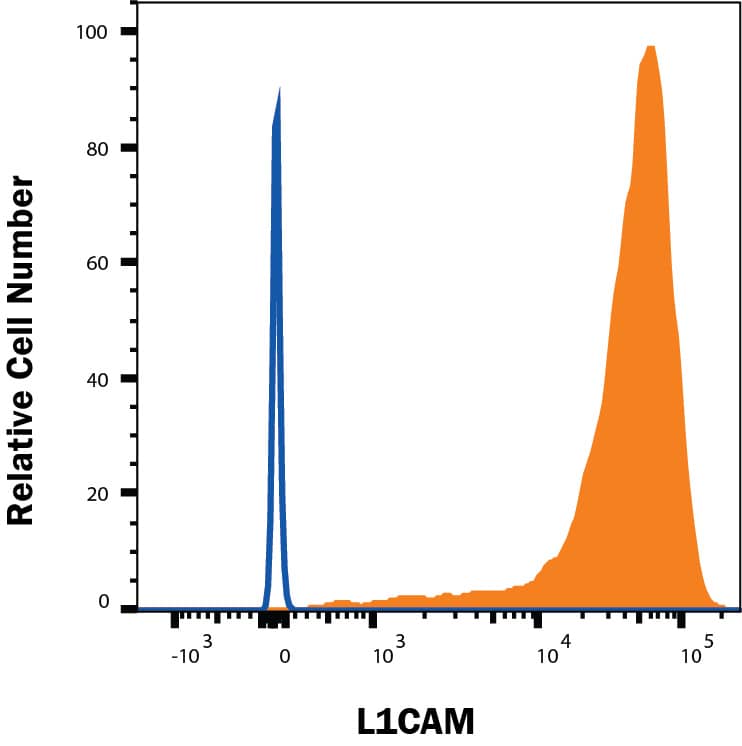Mouse L1CAM Antibody
R&D Systems, part of Bio-Techne | Catalog # MAB5674


Conjugate
Catalog #
Key Product Details
Species Reactivity
Validated:
Mouse
Cited:
Mouse
Applications
Validated:
CyTOF-ready, Flow Cytometry
Cited:
ELISA Capture, Immunocytochemistry, Immunohistochemistry, Western Blot
Label
Unconjugated
Antibody Source
Monoclonal Rat IgG2A Clone # 555
Product Specifications
Immunogen
Mouse cerebellum-derived partially purified L1CAM
Specificity
Detects mouse L1CAM in direct ELISAs. In direct ELISAs, no cross-reactivity with recombinant human (rh) ALCAM, rhBCAM, rhEPCAM, rhMCAM, rhNCAM, rhNCAM-L1, rhOBCAM, recombinant mouse (rm)MAdCAM-1, or rmOCAM is observed.
Clonality
Monoclonal
Host
Rat
Isotype
IgG2A
Scientific Data Images for Mouse L1CAM Antibody
Detection of L1CAM in Mouse Splenocytes by Flow Cytometry.
Mouse splenocytes were stained with Rat Anti-Mouse L1CAM Monoclonal Antibody (Catalog # MAB5674, filled histogram) or isotype control antibody (MAB006, open histogram), followed by Phycoerythrin-conjugated Anti-Rat IgG F(ab')2Secondary Antibody (F0105B).Detection of L1CAM in Neuro-2A cells by Flow Cytometry.
Neuro-2A cells were stained with Rat Anti-Mouse L1CAM Monoclonal Antibody (Catalog # MAB5674, filled histogram) or isotype control antibody (Catalog # MAB006, open histogram), followed by Phycoerythrin-conjugated Anti-Rat IgG Secondary Antibody (Catalog # F0105B). View our protocol for Staining Membrane-associated Proteins.Applications for Mouse L1CAM Antibody
Application
Recommended Usage
CyTOF-ready
Ready to be labeled using established conjugation methods. No BSA or other carrier proteins that could interfere with conjugation.
Flow Cytometry
0.25 µg/106 cells
Sample: Mouse splenocytes and Neuro-2A mouse neuroblastoma cells
Sample: Mouse splenocytes and Neuro-2A mouse neuroblastoma cells
Formulation, Preparation, and Storage
Purification
Protein A or G purified from hybridoma culture supernatant
Reconstitution
Reconstitute at 0.5 mg/mL in sterile PBS. For liquid material, refer to CoA for concentration.
Formulation
Lyophilized from a 0.2 μm filtered solution in PBS with Trehalose. *Small pack size (SP) is supplied either lyophilized or as a 0.2 µm filtered solution in PBS.
Shipping
Lyophilized product is shipped at ambient temperature. Liquid small pack size (-SP) is shipped with polar packs. Upon receipt, store immediately at the temperature recommended below.
Stability & Storage
Use a manual defrost freezer and avoid repeated freeze-thaw cycles.
- 12 months from date of receipt, -20 to -70 °C as supplied.
- 1 month, 2 to 8 °C under sterile conditions after reconstitution.
- 6 months, -20 to -70 °C under sterile conditions after reconstitution.
Background: L1CAM
presenilin/ gamma-secretase is essential for the nuclear signaling of L1CAM in human carcinoma cell lines (1). Defects in L1CAM are the cause of the neurological MASA/CRASH syndrome (5, 6).
References
- Riedle, S. et al. (2009) Biochem. J. 420:391.
- Kenwrick, S. and P. Doherty (1998) Bioessays 20:668.
- Crossin, K.L. and L.A. Krushel (2000) Dev. Dyn. 218:260.
- Maretzky, T. et al. (2005) Mol. Cell. Biol. 25:9040.
- Kamiguchi, H. et al. (1998) Mol. Cell Neurosci. 12:48.
- Striha, L. et al. (2000) J. Child Neurol. 15:239.
Long Name
Cell Adhesion Molecule L1
Alternate Names
CAML1, CD171, HSAS, HSAS1, MASA, MIC5, NCAM-L1, S10, SPG1
Gene Symbol
L1CAM
Additional L1CAM Products
Product Documents for Mouse L1CAM Antibody
Product Specific Notices for Mouse L1CAM Antibody
For research use only
